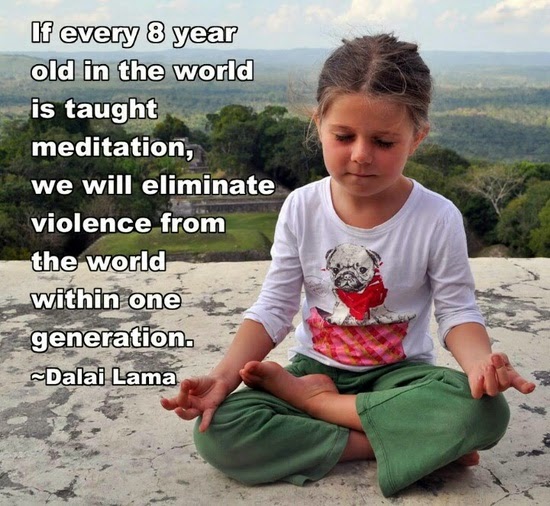Sometimes when I have mentioned mindfulness to someone I've just met, they will ask me, "What's Mindfulness?" Well, it's not Buddhism or any religion, nor meditation or yoga, which are tools that we can use on the way to Mindfulness.
Kabat-Zinn's working definition of Mindfulness is "paying attention on purpose non-judgementally in the present moment as if your life depended on it." Now that's a mouth full! For me, being mindful means being fully awake, aware, alive in the present moment.
The last three characteristics of Doing versus Being (or of Mindfulness) mode are as follows:
5. Avoidance versus approaching--
Instead of trying not to think of something, such as some fear, which only enhances your anxiety, the Being mode encourages you to approach and to acknowledge the very thing that you feel like avoiding. This compassionate approach gradually dissipates the power of your negative feelings.
6. Mental time travel versus remaining in the present moment--
Living in the past often puts you in a regretting mood ,while living in the future may put you in worry mode. "We re-live past events and re-feel their pain, and we pre-live future disaster and pre-feel their impact," write Williams and Penman.
Don't allow yourself to get lost in a mental time warp. See memory as memory and worrying as worrying. Consciously know that you are remembering or that you are worrying about or planning for the future. This acknowledging helps free you from being a slave to mental time travel. You will be able to avoid the extra pain that comes from re-living the past or pre-living the future.
7. Depleting activities versus nourishing activities--
Sometimes life gets so demanding with projects in our professional lives and in our personal lives with on-going projects such as homemaking, childcare, or elder care that it's tempting to focus on these projects to the exclusion of our own health and well-being. You tell yourself that such busyness is temporary, and so you forego interests, hobbies, and pastimes that nourish your soul. Such thinking and Doing can drain away your energy and innate happiness.
For me, teaching would drain away my energy, but when I found kayaking, I discovered something that could replenish my energy and spirit. Nature and river and trails! And kayaking a white water river could always keep me very mindful and present; actually, that's true of any river really. Somehow being out on the river with the sky above me and the water (and sometimes those mountains) all around me connects me to and nourishes my soul.
------------
In the past and most of my life, I have lived too much in my mind, constantly analyzing, and striving for perfection and approval. I had thought that my thoughts were reality, that they were me, that they were true, and I probably avoided those who didn't think the way I did. My mind was often in the past (if only a few hours back regretting something I had said or done) or in the future (if only a few hours ahead planning for the next day's lesson!), and I found myself often fatigued, even exhausted at the day's end.
According to Williams and Penman, characteristics of the Doing mode include judging everything, comparing the way things are with the way you want them to be and striving to make them different from how they actually are. Being on automatic pilot much of the time and getting lost in thoughts that you take too literally and personally. Living in the past or future and avoiding what you don't like. Finally, the Doing mode sees the world indirectly, through a veil of concepts [delusions] that short-circuit your senses so that you no longer directly experience yourself and the world.
Is this the way that you want to live your life? I have been extremely guilty of taking things too literally and too personally. And of trying to "improve" things that I really had little power over. What a waste of precious time and energy!
Characteristics of the Being or the Mindfulness mode include nourishing activities, being in the present moment, approaching and acknowledging, viewing thoughts as mental events, accepting, sensing, and conscious choices.
Would you like to live your life this way? I know that that is how I want to live!
To make a conscious shift to the Being or Mindful mode takes practice. After all, it took many decades for us to "perfect" this Doing mode of rapidly getting things done or jumping from one task to another or multi-tasking.
Toward the end of my teaching career, as my students would call out my name for attention time and again, I would tell them that I could only mono-task! That's one way I slowly began to shift gears to the Being mode or to becoming more mindful.
So how do we begin to shift gears? How do we engage ourselves with the Being mode? How do we become more mindful?
In the present moment, of course.
To be continued . . .




No comments:
Post a Comment